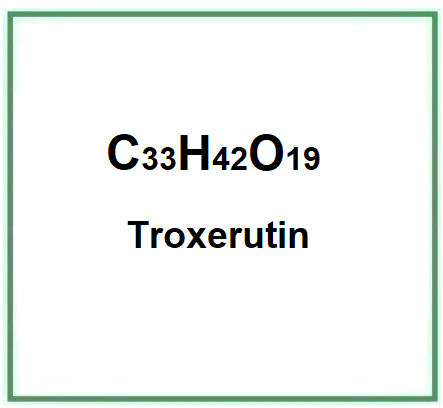Troxerutin is a naturally fluorescent bioflavonoid, a derivative of rutin, which is produced as a semi-synthetic flavonoid by extraction from the deciduous plant Sophora Japonica (Styphnolobium japonicum) belonging to the Fabaceae family, or by hydroxyethylation of rutin (3-hydroxy-rutin).

It occurs naturally in tea, cereals, olives, coffee and in vegetables and fruit. Industrially it appears in the form of a yellowish or brown water-soluble powder.

What it is used for and where
Medical
Troxerutin which is known as Vitamin P4, due to its anti-inflammatory, antioxidant properties is used in the treatment of chronic venous insufficiency (1), is an effective radioprotective agent (2), can increase the oxygen content of the blood, improve microcirculation and form new blood vessels. It can be used as an adjuvant in the treatment of various diseases attributed to oxidative stress (3) and improve skin care products (4).
Sicurezza
Troxerutin did not demonstrate any cytotoxic, genotoxic or mutagenic effects after 24-hour exposure (5).
Cosmetics
Skin conditioning agent. It is the mainstay of topical skin treatment as it has the function of restoring, increasing or improving skin tolerance to external factors, including melanocyte tolerance. The most important function of the conditioning agent is to prevent skin dehydration, but the subject is rather complex and involves emollients and humectants that can be added in the formulation.
- Molecular Formula C33H42O19
- Molecular Weight 742.7
- CAS 7085-55-4 31511-30-5
- UNII 7Y4N11PXO8
- EC Number 230-389-4 250-670-5
Synonyms:
- Vitamin P4
- 3-hydroxy-rutin
- Trioxyethylrutin
- Troxerutine
References_____________________________________________________________________
(1) Carlsson, K., Patwardhan, A., Poullain, J.C. and Gerentes, I., 1996. Transport and localization of troxerutin in the venous wall. Journal des Maladies Vasculaires, 21, pp.270-274.
(2) Ping, X., Junqing, J., Junfeng, J. and Enjin, J., 2011. Radioprotective effects of troxerutin against gamma irradiation in V79 cells and mice. Asian Pac J Cancer Prev, 12(10), pp.2593-2596.
(3) Panat NA, Maurya DK, Ghaskadbi SS, Sandur SK. Troxerutin, a plant flavonoid, protects cells against oxidative stress-induced cell death through radical scavenging mechanism. Food Chem. 2016 Mar 1;194:32-45. doi: 10.1016/j.foodchem.2015.07.078.
(4) Kessler M, Ubeaud G, Walter T, Sturm F, Jung L. Free radical scavenging and skin penetration of troxerutin and vitamin derivatives. J Dermatolog Treat. 2002 Sep;13(3):133-41. doi: 10.1080/09546630260199505.
(5) Cavalcanti, B.C., Neto, J.B.D.A., Silva, A.A.D.S., Barreto, F.S., Ferreira, J.R.D.O., Magalhães, H.I.F., Silva, C.R.D., Vieira, I.G.P., Ricardo, N.M.P.S., Nobre Junior, H.V. and Moraes, M.O., 2021. Chemopreventive effect of troxerutin against hydrogen peroxide-induced oxidative stress in human leukocytes through modulation of glutathione-dependent enzymes. Journal of Toxicology and Environmental Health, Part A, 84(4), pp.137-151.
![]() Troxerutin
Troxerutin 







